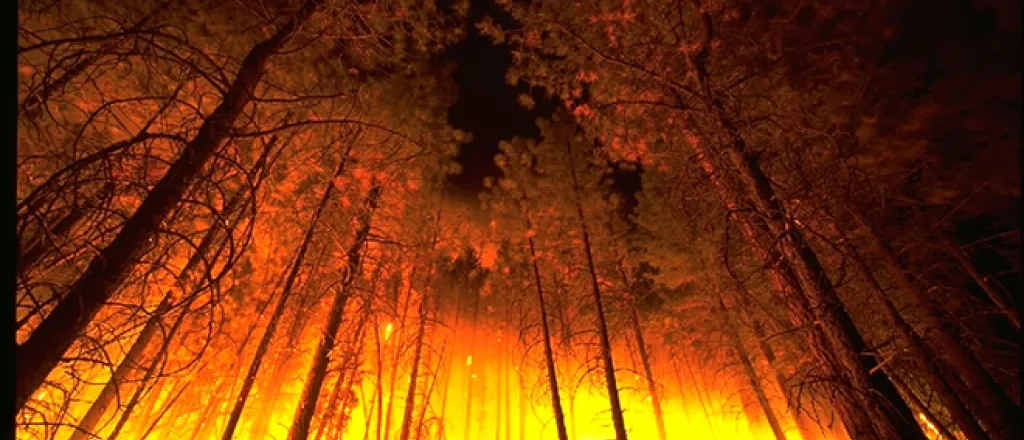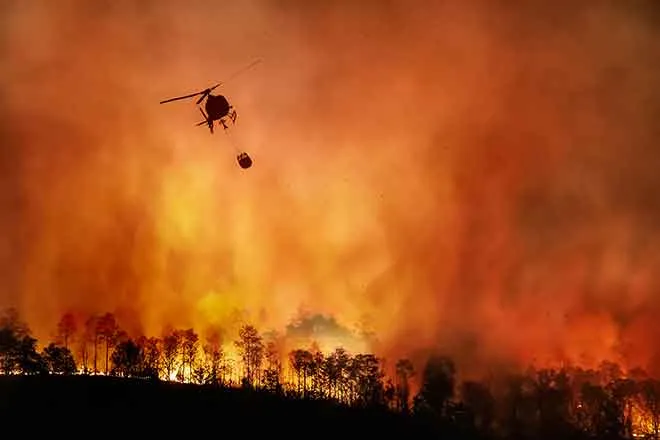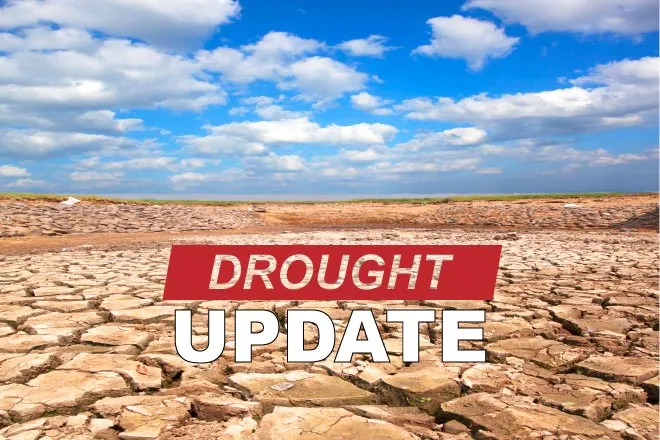
Mushrooms can help prevent mega-wildfires
Click play to listen to an abbreviated version of this article.
(Colorado News Connection) If you’ve gone walking in the woods out West lately, you might have encountered a pile of sticks. Or perhaps hundreds of them, heaped as high as your head and strewn about the forest like Viking funeral pyres awaiting a flame.
These slash piles are an increasingly common sight in the American West, as land managers work to thin out unnaturally dense sections of forests — the result of a commitment to fire suppression that has inadvertently increased the risk of devastating megafires.

© Rohan Bakshi - iStock-1150309753
“We have an epidemic of trees in Colorado,” said Stefan Reinold, a forester with Boulder County’s Parks and Open Space department. In the Rocky Mountain forests that he manages, a century of stamping out wildfires as soon as they arose failed to account for the role fire plays in maintaining healthy forest ecosystems. Today, the resulting abundance of densely packed pines and firs fuels huge blazes.
In response, the federal government has committed nearly $5 billion in the Inflation Reduction Act and Bipartisan Infrastructure Law to thinning forests on about 50 million Western acres over the next 10 years. Although this can be accomplished with prescribed burns, the risk of controlled fires getting out of hand has foresters embracing another solution: selectively sawing trees, then stripping the limbs from their trunks and collecting the debris.
The challenge now is what to do with all those piles of sticks, which create fire hazards of their own. Some environmental scientists believe they have an answer: mushrooms. Fungus has an uncommon knack for transformation. Give it garbage, plastic, even corpses, and it will convert them all into something else — for instance, nutrient-rich soil.
Down where the Rocky Mountains meet the plains, in pockets of forest west of Denver, mycologists like Zach Hedstrom are harnessing this unique trait to transform fire fuel into a valuable asset for local agriculture.
For Hedstrom, the idea sprung from an experiment on a local organic vegetable farm. He and the farm owner had introduced a native oyster mushroom to wood chips from a tree that fell in a windstorm. “That experiment showed us that the native fungi were helping to accelerate the decomposition really substantially,” he said. Working with local governments, environmental coalitions, and farmers, he is now honing the method.
As part of its regional strategy, the U.S. Forest Service plans to thin more than 47 square miles — an area larger than Disney World — along Colorado’s Front Range. Hundreds of thousands of slash piles already lay in wait here until conditions are right for burning. Ideally, this means snow on the ground, moisture in the air, and little wind. It can be a hard recipe to come by.

© iStock - Toa55
When slash piles are set alight, they burn longer and hotter than most wildfires over a concentrated area. This leaves behind blistered soil where native vegetation struggles for decades to take root. As an alternative, foresters have tried chipping trees on-site and broadcasting the mulch across the forest floor, where it degrades at a snail’s pace in the arid climate. Boulder County also carts some of its slash to biomass heating systems at two public buildings. “We’re removing a ton of wood out of forests for fire mitigation,” Hedstrom said. “This is not a super sustainable way of managing it.”
He hopes to show that fungi can do it better.
Jeffrey Ravage is a forester with the Coalition for the Upper South Platte, which manages protection and restoration of a more-than-million-acre watershed in the mountains southwest of Denver. He describes the action of saprophytes, a type of fungi that feeds off dead organic matter, as “cold fire.”
Like a flame, saprophytic fungi break organic material into carbon compounds. Mycelium, the often unseen, root-like structure of the fungi, secretes digestive enzymes that release nutrients from the substrate it consumes. Whereas a flame destroys nearly all organic nitrogen, mycelium can fortify nitrogen where it’s needed in the forest floor.
“We do hundreds to thousands of acres of fire mitigation a year,” Ravage said.
Standard thinning costs somewhere around $3,000 per acre, about a third of which is spent hauling out or burning the slash. Using mycelium could drastically reduce that cost. With the right kind of fungi, Ravage said, “we can do in five years what nature could take 50 years to a century to do: create organic soil.”
Though the method is new, it’s not untried. At the Balcones Canyonlands Preserve, north of Austin, Texas, biologist Lisa O’Donnell deploys mycelium to combat invasive glossy privet that spills over from surrounding urban sprawl. After the intrusive trees are cut and piled, volunteers inoculate — or seed — them with native turkey tail fungi, which take about three years to transform hard logs into crumbly sponges.
Eventually, the woody material breaks down into a rich and water-retentive loam that O’Donnell uses to rebuild the Balcones’ deteriorated soils. “You don’t have to burn it or haul it out. You’re using that biomass, keeping it in place and recycling it,” she said. “You’re turning a negative into a positive.”
For mycelium to be a truly viable solution to wildfires, however, it would have to work at the scale of the Western landscape. Hedstrom is experimenting with brewing mycelium into a liquid that can be sprayed across hundreds of acres. “It’s a novel biotech solution that has great promise but is in the early stages,” he said.
Ravage doubts it could be so easy. “Half the battle is how you target the slash,” he said. Success stories like the Balcones are rare. Ravage has spent a decade cultivating wild saprophytes and perfecting methods of applying them in Colorado’s forests.
He begins by mulching slash to give his fungi a head start. Then he seeds the mulch with spawn, or spores that have already begun growing on blocks of the same material, and wets them down. Fungi require damp conditions and will survive in the mulch if it is piled deeply enough. Given the changing character of Western forests, however, aridity poses a serious hurdle.
At his lab in the Rockies, Ravage grows about a ton of spawn annually. To meet the demands of forest-fire mitigation, he wants to produce 12 tons every week. This presents an opportunity for intrepid mushroom farmers, should the government choose to fund them, but it’s not the only way agriculture could benefit. “There’s going to be a lot of wood chip waste continuously coming out of the forest,” said Andy Breiter, a rancher in Boulder County. “We can use those resources.”
Some Front Range farmers pay to truck in compost from Vermont. Instead of adding synthetic fertilizers or importing compost, Breiter is using Hedstrom’s mycelium to turn forest slash into organic soil that he can work into his degraded land. “I’m trying to increase the productivity of my land while recognizing that past systems of productivity created these problems to begin with,” Breiter said.
Stephen Robert Miller wrote this article for the Food and Environment Reporting Network.














